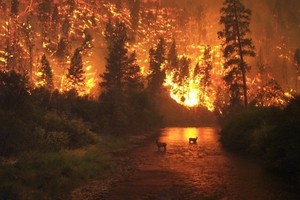
FAIRBANKS, Alaska — Hundreds of wildfires are continually whipping across this state this summer, leaving in their wake millions of acres of charred trees and blackened earth. At the Fairbanks compound of the state’s Division of Forestry recently, workers were busy washing a mountain of soot-covered fire hoses, which stood in piles roughly six feet high and 100 feet long. About 3,500 smokejumpers, hotshot crews, helicopter teams and other workers have traveled to Alaska this year from across the country and Canada. And they have collectively deployed about 830 miles of hose this year to fight fires.

“People don’t fathom how big Alaska is. You can have a 300,000-acre fire, and nobody knows anything about it, because nothing’s been done about it, because of where it is,” says Tim Mowry, spokesman for the Alaska Division of Forestry.

Fire ravages the Alaskan wilderness (Flickr/Image Editor)
The staggering 2015 Alaska wildfire season may soon be the state’s worst ever, with almost 5 million acres already burned — an area larger than Connecticut. The pace of the burn has moderated in the last week, but scientists say the fires are just the latest indicator of a climatic transformation that is remaking this state — its forests, its coasts, its glaciers, and perhaps most of all, the frozen ground beneath — more than any other in America.

Left-hand image shows location of fires; right-hand maps the trail of ozone (NASA: Aqua MODIS,OMPS)
Alaska has already warmed by more than 3 degrees Fahrenheit in the past half-century, much more than the continental United States. The consequences have included an annual loss of 75 billion metric tons of ice from its iconic glaciers — including those covering the slopes of Denali, the highest peak in North America — and the destabilization of permafrost, the frozen ground that underlies 80 percent of the state and whose thaw can undermine buildings, roads and infrastructure.
Also pummeled are the state’s Arctic coastlines, which are facing intense erosion as seas rise and declining sea ice exposes shores and barrier islands to punishing waves. The situation has grown so bad that some native communities, including tiny Kivalina, Alaska, sitting on a barrier island along the Chukchi Sea, may now have to be relocated, given the dangerous loss of land to the sea.
Earlier snowmelt transforms the state further. In 2015, the starting place of the Iditarod sled dog race had to be relocated north, to Fairbanks, because there wasn’t enough snow on the ground in some places.
But arguably the most dramatic change — threatening to transform the state’s 126 million acres of forests and, perhaps, worsen climate change in the process — is occurring with the state’s wildfires.
Alaska’s forests make up 17 percent of the U.S. total, and while they’ve always burned, they may now be entering a major new combustive period. The blazes are so intense and extensive that they could transform an entire ecosystem, even as the fires also hasten the thawing of permafrost — which itself contains vast quantities of ancient carbon, ready to be emitted to the air.
